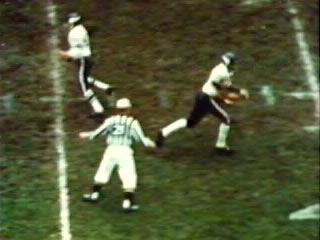The safety. The scourge of and/or best friend to the against-the-spread gambler and by far the most exciting play in football for a fan of dominating defense.

The general rule is that a safety is recorded whenever the ball would be spotted in a team's own end zone. The defense then gets two points, and the offense free kicks back to the defense from their own 20. Two points and possession in good field position -- obviously, quite devastating.
There are five major ways to record a defensive safety (tackled in the end zone, fumble out of the end zone, blocked punt in the end zone, intentionally kneeling to take one, committing a penalty (holding, intentional grounding) where the enforcement spot is in the end zone). Six, if you count Jim Marshall running the wrong way and underhand tossing the ball to a fan in his own end zone. However, most people are unaware that there are one-point safeties as well. In the NFL, if a team is going for two and loses possession of the ball, and the defending team recovers the ball and retreats into their own end zone, where they are tackled, the offensive team records a safety and is awarded one point. This has never happened in th e NFL, but has happened in college football, in a 2004 game between Texas and A&M.
 Jim Marshall learning that when the referee looks confused, you're doing something wrong.
Jim Marshall learning that when the referee looks confused, you're doing something wrong.spacer
In college, there is a defensive one-point safety. Unlike the NFL, in college a turnover on a conversion attempt (one-point or two) can be run back by the defensive team for two points. However, it is theoretically possible that the defensive team could run a turnover back, lose the ball near the original kicking team's own end zone, and record a one-point safety by tackling a kicking team player who takes the ball into his own end zone (the one 98 yards away from where the conversion initially took place.) This has never happened. It is, however, the only way for a team to finish a game with a score of one, though the team could never win 1-0, as a touchdown is required for the other team to get the whole scenario rolling.
The NFL and college records for safeties in a game is three, held by the L.A. Rams in the NFL and Arizona State, North Texas and Bowling Green in college. Two NFL games have ended in overtime on safeties, one on a blocked punt and one on a fumble. One L.A. Ram, Fred Dryer, holds the distinction of being the only man to record two safeties in a game (not in the same game the Rams recorded three). I remember reading that some games in the 1930s ended 2-0, but I can't find it now.
If you think that's exciting, wait until I post about the rouge/single in CFL football. It will blow your mind.

7 Responses:
For the record, I threw an interception on a conversion attempt in flag football and then failed to de-flag the defender on his way to an embarassing two-point defensive conversion.
Also for the record, I got concussed during a flag football game, got my chin split open, and J-Red almost beat the shit out of the guy who did it. Of course, I went to a Maryland basketball game that day before going to the hospital and the people at the hospital looked at me like I was nuts when I strolled in there slightly dazed with gauze on my chin and told them about my injury 12 hours earlier. Gotta love those intramural fields at Maryland with the 1/16 inch of Astroturf on top of concrete.
I'm not down with a 1-point safety. Time for a rule change.
I think calling it a safety is large semantics, though it does result from the point of enforcement being in the team's own end zone.
Well, you may claim de minimis non curat lex, but the rule doesn't make sense to me.
If the defending team picks up the ball, they are now on offense. If they run it backwards into their own goal and are tackled, is that one or two points? If it's one point, then I guess it's still fair. But I think the only example you gave is if the kicking team takes the ball into its own endzone.
It's also one point. On a conversion attempt, safeties are worth one point, no matter which end zone they happen in. The exception is that in the NFL, a block or fumble on an extra point attempt kills the play. The one-point safeties can only happen on two-point tries in the NFL.
Come on! I wanted some credit for using "de minimis non curat lex."
But if it's one point both ways, I guess I'm down with that.
Case dismissed.
Post a Comment